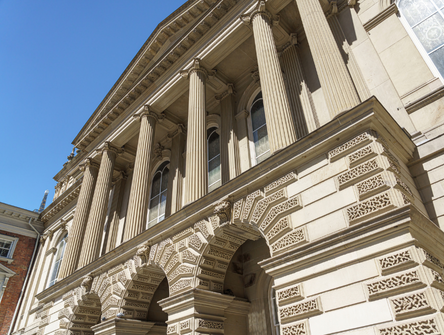No more free entry?
A legal challenge by two First Nations threatens BC's mineral claim system.

It all used to be so simple. Way back in the Wild West days of mineral exploration in Canada, prospectors searching for surface signs of gold, silver or copper would cut down trees at four corners of a small plot to “stake” a claim. All a claim-jumper had to do was knock down the stumps.
It’s harder now — many jurisdictions have moved their claims online, making claim-jumping much less likely. But the basic model of “open entry” underlying exploration rights — the model that allows virtually anyone to stake an exploration claim simply by clicking on a map and paying a fee — remains the dominant model for mining regulation in Canada. In British Columbia, it’s under attack.
In April, the B.C. Supreme Court will hear a challenge to the province’s free-entry mineral tenure system that could send tremors throughout Canada’s mining sector. The Gitxaała and Ehattesaht First Nations launched the challenge against the B.C. government; they argue the free-entry system is unconstitutional because it violates the government’s “duty to consult” with First Nations by allowing exploration without prior consultation.
“The claims system allows anyone to point at a map and make an exploration claim without interacting at all with the Crown or First Nations,” said Merle Alexander, principal lawyer at Miller Titerle in Victoria and a member of Kitasoo Xai’xais First Nation.
“It’s an extraordinarily offensive approach to mineral exploration, even if the claim is never developed.”
Most claims never get off the ground, so to speak.; the Association for Mineral Exploration B.C. told media outlet The Narwhal last year that only one in 10,000 exploration projects ever becomes an actual mine.
“The exploration permit is only the very first step in opening a mine, but it can complicate matters for First Nations negotiating land claims,” said Chris Roine, counsel in Indigenous law at BLG in Vancouver. “When concluding a modern treaty or land claim, for example, the Crown is expected to clear up any third-party entanglements, which often requires compensating claims holders.
“This has happened a few times in settling modern treaties in British Columbia, which was massively irritating to First Nations that couldn’t understand why provincial compensation was going to these rights-holders.”
Interest in the case is high. The B.C. Supreme Court has approved eight intervenors (representing Indigenous communities, human rights and environmental organizations, and the mining industry itself) because the open-entry system is the bedrock of mineral exploration in Canada — and because the case turns on one of the thorniest questions in Indigenous resource law.
“At what point is the Crown’s duty to consult triggered? We’ve seen cases across the country revolving around the same question,” said Sander Duncanson, a partner in regulatory, Indigenous and environmental law at Osler in Calgary.
In the case before the B.C. court, the duty-to-consult gives rise to two key questions. The first, said Duncanson, is whether there’s a “nexus” here between a Crown action and an Indigenous right.
“Arguably, in this case there is no Crown conduct falling into that category,” he said. “An argument could be made that the Crown failed in its duty to consult when the legislation was drafted, but I think that would be a stretch based on the law as it stands.”
The second question, he said, is whether the act of granting exploration rights “in the absence of a physical impact on the land” affects Indigenous rights “by affecting how the landscape may be used down the road.”
“Again, current law suggests that would be a bit of a stretch,” Duncanson added.
There’s a third question, of course. If the court decides the open-entry system is unconstitutional, what could it do?
The B.C. Supreme Court’s decision in Yahey v. British Columbia was the first in Canadian law to recognize an infringement of treaty rights resulting from the cumulative effects of multiple natural resource projects approved over many years, rather than a specific project. In that decision, the court ordered B.C. to stop issuing permits for oil, gas and forestry activities on Blueberry River First Nation territory while the province negotiated a final agreement with Blueberry.
“[The judge] suspended the decision for six months to allow the province to make other arrangements,” said Duncanson. “I’d say something similar in this case is reasonably likely.”
Allan Ingelson, executive director of the Canadian Institute of Resources Law and a professor at the University of Calgary’s law school, agreed there’s a “good argument” for the court ordering the province to remove “the affected lands from permitting until the outstanding issues are resolved.”
“But B.C. will argue, of course, that mineral exploration and exploitation is critical to the province’s economy,” he said. And any attempt by the court to nullify or suspend existing exploration permits, he said, would trigger a landslide of lawsuits.
“If B.C. makes a decision that renders exploration rights worthless, it can expect to be sued. It’s happened before,” said Ingelson.
And any attempt by the court to limit a province’s authority over natural resources would be met by resistance from other provinces, he added.
“If the judges made a judgement that removed that jurisdiction from provinces, there would be a backlash,” he said. “So I can’t see the courts saying, ‘We’re going to give you time to come up with something different.’”
But B.C. still has an obligation to reform its system for awarding exploration rights, said Alexander — because in 2019, it became the first province to pass legislation to legally implement the United Nations Declaration on the Rights of Indigenous Peoples (UNDRIP).
“B.C. has already agreed through legislation to reconcile all of its laws with UNDRIP,” he said. “This permitting system seems like an obvious place to start.”


